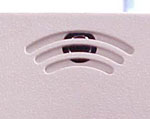When
they aren't on all monitors are just about equal. Naturally they aren't much use that way either. Proview make budget monitors, and they appeal to anyone who doesn't really need anything too exact -
display wise. For the most part the sharpness of their screens is satisfactory, but
not too great. Often the closer to the edge the fuzzier the picture gets.
While this would make any graphic artist go crazy, they
do serve a very useful purpose. If you consider that most of the people on the
internet are not surfing around on $1000 19" Sony
displays with the most advanced CRT's out there then you'll realize that this little workhorses
of a monitor are probably how a good chunk of the world sees the web. That being clear for the most part, but at times a little fuzzy, with sometimes poor contrast. To those
graphic artists out there creating entire sites of black, and 80% grey, just consider
the people looking at those kinds of pages are gonna see not to much...
 Okay, getting back to the monitor. Despite its low price-point the Proview PX-772 does manage to throw in a few rather cool features. The OSD display button-knob is
a rather neat and intuitive way to access the on screen controls of the
monitor, and works a lot better then multiple buttons do from a users standpoint.
Okay, getting back to the monitor. Despite its low price-point the Proview PX-772 does manage to throw in a few rather cool features. The OSD display button-knob is
a rather neat and intuitive way to access the on screen controls of the
monitor, and works a lot better then multiple buttons do from a users standpoint.
Interestingly the PX-772 also comes with an
integrated microphone. In the past we've mainly just seen this kind of feature with
Macintosh monitors, so it is rather welcome, though unexpected from such an inexpensive display.
Continuing along with the audio theme, this
Proview display also has integrated audio jacks on either side. While they're not there for a couple sets of headphones - now that would be an amazing feature! - but rather for a pair
of optional speakers which can be ordered separately. The speakers, if you've go them,
hang off the display on either side and give you that whole home-theatre feeling.
Resolution and picture quality with this
monitor are not as good as I would have hoped. Picture quality and
sharpness decrease towards the edges slightly, so we have to knock a few points
off the Proview's overall score for that. When resolution gets pumped up to the
max value of 1024x768 this problem is most evident. Next we turned up the brightness and contrast
all the way to see what impact this had on picture quality. The display fairs
average in this category, and definitely better then an older Proview model which basically craps out showing the masking behind the glass and loosing a lot of picture quality. Although there are only a few
colour temperatures the range is fully adequate. A temperature of about 6500K looked to
be the optimal setting as it was not too warm, and not overly cold.
Colour temperature is specified in Kelvins, with 9300K representing the temperature of sunlight. The lower
the number, the more blue is displayed on the screen.
The Proview PX-772 operates at a conservative number of
resolution and frequency settings. However they are sufficient selections for a
17" monitor. Anything above a 1280pix would make the screen overly
difficult to read.
A CRT monitor refreshes the display
many times per second. The vertical frequency is the defining value as it
refers to the frequency with which the display is refreshed. Hence it is
called the 'Refresh Rate' and measured in Herz. Making a comparison for a moment
electricity from the wall cycles at 60Hz for most of the world. If a monitor
were set to this refresh rate the screen would visibly flicker. Generally a
refresh rate of 75Hz or above is used to reduce noticeable flicker. What
this equates to is a higher refresh rate is best, and anything around 80Hz is
superb.
The
horizontal frequency refers to the rate at which a horizontal line can
be scanned from its left to right end. The horizontal frequency
is the reciprocal of the horizontal cycle and is in measured in KHz. A
higher horizontal frequency is naturally required if there is to a higher
vertical frequency.
